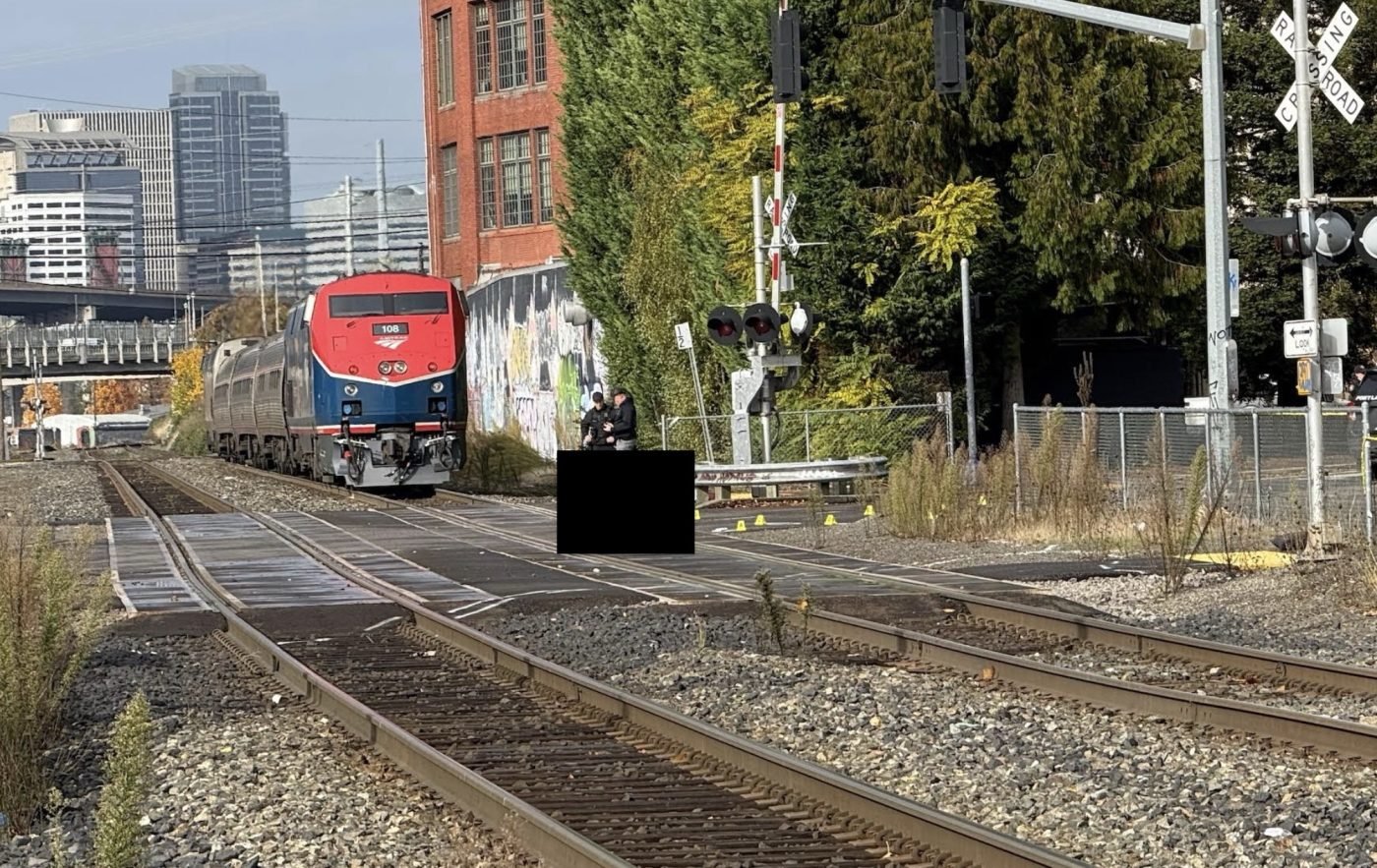
Just after 10:00 am this morning someone riding an electric scooter died following a collision with an Amtrak train. According to photos from witnesses at the scene shared with BikePortland, it happened at the sidewalk crossing of the rail tracks where they intersection with SE 11th/SE Milwaukie Avenue.
The deceased person’s body came to rest on the sidewalk located just north of the northernmost track, just beyond the Ford Building parking lot. According to photos that show the e-scooter and other investigative markings, it appears the collision might have originated at the eastern end of the crossing. Also clear in the photos is that the person was riding a Lime e-scooter that’s part of the City of Portland’s shared electric scooter system.
Police haven’t released any further details.
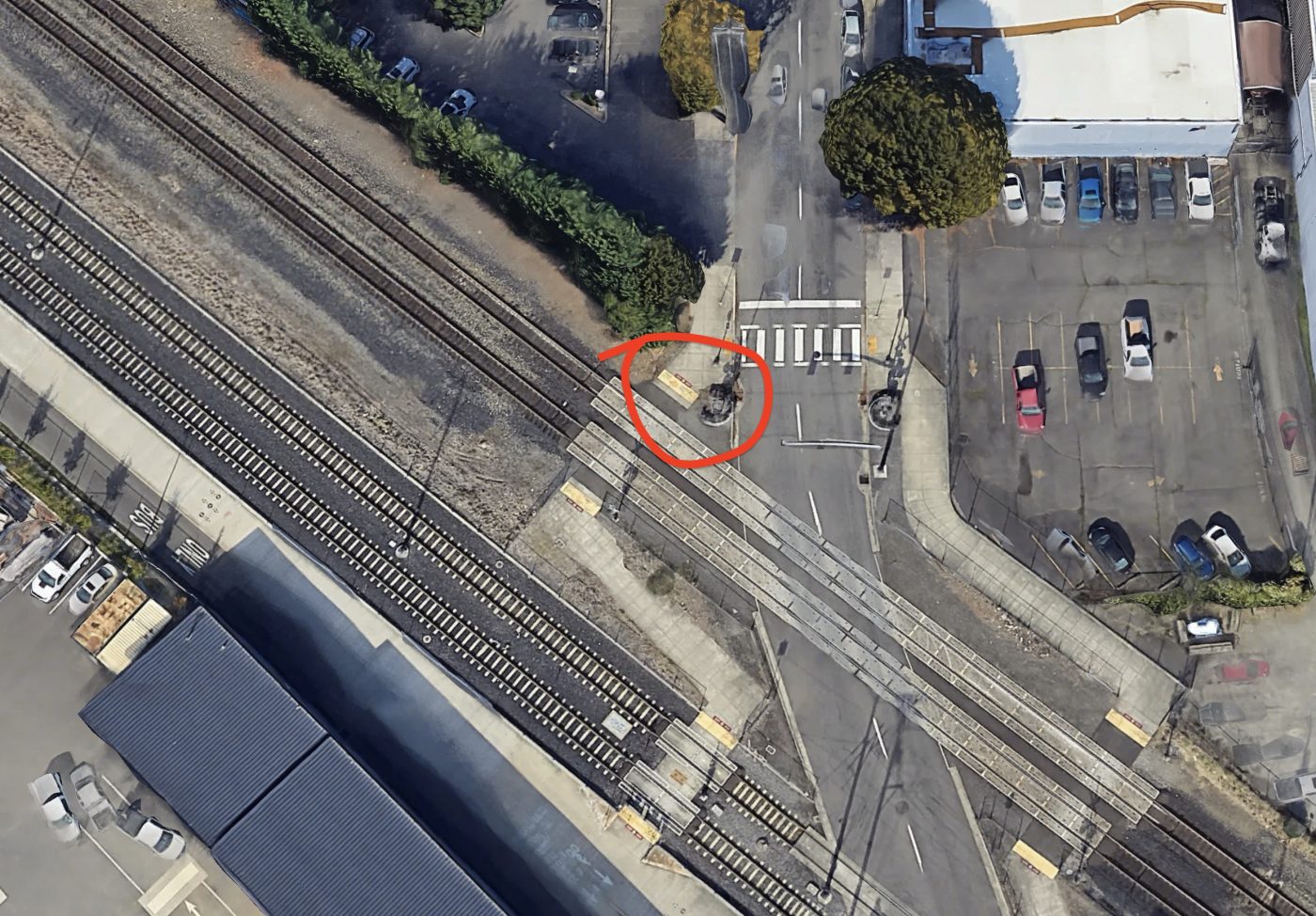
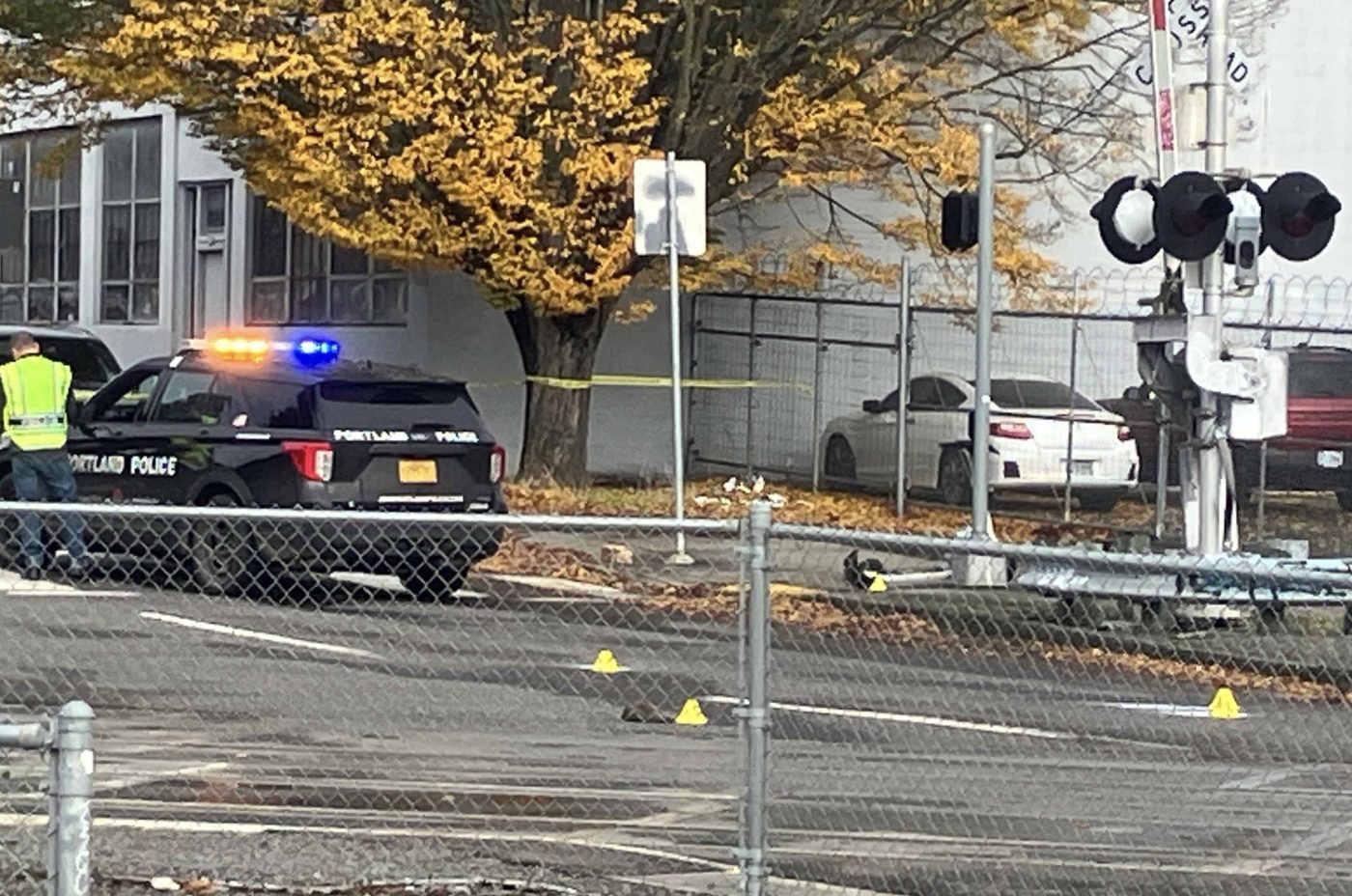
This is the second fatal collision at these tracks this year. Back in June, a man riding a bicycle was attempting to cross SE 8th in the main roadway prior to being struck and killed by a MAX light rail train.
Since August of this year there have been four fatal crashes involving e-scooter riders. On August 17th a man died from his injuries after being involved in a collision with a tractor-trailer operator near NE Martin Luther King Jr Blvd and NE Holladay St. One day later, a man hit a pothole near SE 52nd and SE Mitchell while riding an e-scooter and later died from his injuries. And on October 22nd, a woman riding a Lime e-scooter collided with another vehicle operator at N Vancouver and N Weidler and died in the hospital one week later.
This is the 36th fatal crash on Portland streets so far this year.

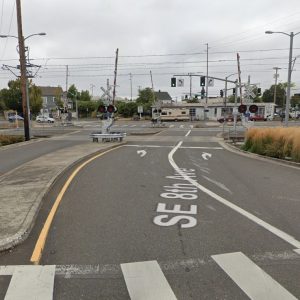
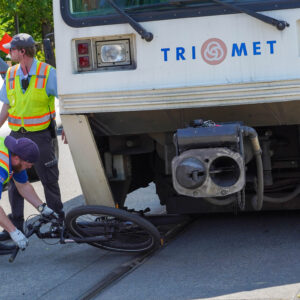
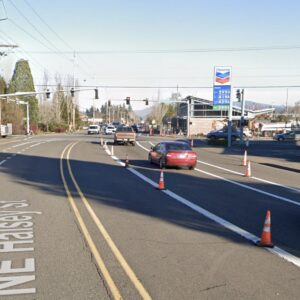
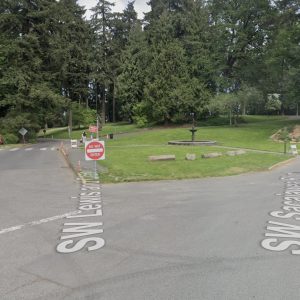
Thanks for reading.
BikePortland has served this community with independent community journalism since 2005. We rely on subscriptions from readers like you to survive. Your financial support is vital in keeping this valuable resource alive and well.
Please subscribe today to strengthen and expand our work.
Will this death be the motivation (finally) to build a cycling / ped bridge over these tracks? It is the WEST COAST MAINLINE, and it runs through the heart of a major city.
Build the bike / ped bridge and people will use it.
There is one, about a block to the south.
There are multiple options in the area if one wants to avoid the conflict with trains completely: SE 14th overcrossing, Powell Underpass (generally sketchy), and the Rhine overcrossing. However, any overpass is going to take longer than an Amtrak train, so I doubt that the availability of an overcrossing at 11th/12th would prevent collisions like the one here. The vast majority of e-scooter and bike riders will opt for a clear level crossing, and it only takes a few seconds for one of these Amtrak trains to pass by, as they are generally doing 40+ mph here.
An important reminder that these multi-track crossing can be especially dangerous with a mix of slow freight trains and faster passenger trains. There is a desire to cross just after the freight train passes, but the train may be obscuring another train on the next track over. Wait for the lights to stop before crossing.
Most cities put up huge fences and barriers to block off streets completely. I wonder, why hasn’t Portland done this yet?
There’s a bridge 3 blocks away at SE 14th (and then the other one at Lafayette as well).
https://maps.app.goo.gl/iWf5tWNZiuM6Nw7r9
How many bridges over the tracks would you recommend?
There is a nearby walk/roll overpass.
One for the train— or for all users along that specific desire line—remains a pipe dream unless you can convince the railroad to shut down for a year and move out of Brooklyn Yard for Marion or Clark County.
The railroad didn’t shut down for a year for the Bob “should have been a ramp, broken elevator” Stacey Crossing.
I agree. Building a bridge that people will encounter and know to use on the most frequently used routes would be much more intuitive and better than an unreliable elevator. Many people will not know all their options or how dangerous an area is. In addition to being safer, it would make this route much more usable.
Heck yeah, SD! I’m sure the grieving family is consoled by all of the comments about how there’s an overcrossing just a few blocks away.
If it ain’t convenient, people aren’t gonna use it.
Even when it is convenient people don’t use “it” . . . look at all the people who will go out into traffic even when there’s a crosswalk less than 50′ away.
We live in a society whose culture is to “screw the rules” because we are so independent . . . yeah does a lot of good when you get hurt.
Why?
The simple solution is to pay attention. No need for an expensive solution that doesn’t eliminate the problem. Even with a bridge someone on a scooter is likely to continue scooting.
Tragic. Condolences to the family and friends of the deceased.
Should we now declare war on trains?
You just couldn’t resist that last sentence huh Angus?
Maybe. If, you know, the “war on cars” is really about saving lives.
https://www.theatlantic.com/technology/2025/10/brightline-train-florida/684624/
The war on trains for human transportation in the US was declared a long time ago.
Combining freight and passenger on the same tracks that run through busy transportation areas for transit, pedestrians and bikes is an outcome of this war. If you wanted to make a more insightful comment, you could say, “should we now declare a war on incorporating dangerous transportation infrastructure into human habitat without sufficient separation or safe guards?”
Wonderful, nuanced comment. The whole “war on cars” approach is so unfortunate, since it sounds like a black-and-white “cars bad” argument.
If you ask me, it’s not all that unfortunate. What is way more unfortunate is the widespread impatience and willful ignorance that prevents the freshly initiated from understanding the concept and movement.
Cars are certainly one of the worst inventions, along with gunpowder and smart phones, to have cursed the globe.
Not to mention sanitation and medicine, that have allowed us to reproduce in such prodigious numbers without getting knocked back by pandemics and disease.
You mean the rail lines that have been there since a few years after the Civil War ended?
I’ve traveled on numerous Amtrak trains many many times, and only on 4 trips has a train hit someone – three were fatal pedestrian hits and the 4th we hit a semi-trailer crossing through a gated crossing illegally (the driver walked away unhurt but the trailer full of agricultural chemicals was wrecked). It often takes a half-mile for a passenger train to stop (unlike MAX), and often half the body is at one location and the rest is elsewhere. The shortest stop for a police investigation I’ve experienced was about 45 minutes; the semi took 9 hours to investigate before our train was able to leave (or rather be dragged away by a UP locomotive – our train engines got burned out by stopping too quickly.)
Know what the impact you feel on the train when it hits someone? Zero. You don’t feel it at all, even when we hit the semi (near Salem OR.)
I’m curious if the emergency braking felt jarring at all. I’m guessing it didn’t, but all of my train rides have been uneventful, so I really have no idea.
Twice when hitting people I was on a Cascades train near Kelso or Centralia WA (2 engines + 8 coupled cars), once on the Piedmont between Raleigh and Greensboro (2 engines + 4 or 5 older renovated passenger cars). The smaller trains take a half-mile to stop, but the train that hit the semi was the Coast Starlight which is much longer and heavier, with two engines up front, baggage car, 3+ sleepers, two observation cars, a diner, and at least 5 and maybe 7 passenger cars, all of the older 2-deck type, each of 100 feet long, so at least 1,400 feet in total length, over a quarter-mile. I think the Amtrak train was moving at 65+ mph when it hit the semi, then it stopped within a quarter mile rather than a half mile or more – the conductor told us that both engines were burned out from braking too quickly. It didn’t feel jarring at all, it felt like a MAX train that was slowing down then stopping – apparently there was never any risk of derailment, but our drivers (who are UP employees and not Amtrak personnel) panicked. According to some passengers I talked with, when the train hit the semi, the heavily-loaded trailer did a huge arc in the air before crashing into the ground. Personally I felt nothing and I didn’t know anything was wrong until the conductor made an announcement; Amtrak trains often stop in the middle of nowhere for more or less no reason at all (usually to let another train pass).
Tragic, but those scooters encourage dangerous behavior.
How so? I’m genuinely curious.
How so?
One way that I observed in Bend last month. Two teenagers (appeared to be 14ish) riding helmetless on the Bend rental scooters in Drake Park, the centerpiece park on the river. They were doing wheelies, going against traffic in the bike lane, dodging the many people walking, then to cap it off, they tried to go down some steep stairs (maybe 10 steps). One kid made it, the other crashed, but they both raced away unharmed. Bend has all kinds of rules, laws, public announcements regarding scooter riding, but zero enforcement. The rental fleet is essentially expensive trash; you see them lying around all over town, even now, when nobody appears to be renting them much (getting colder).
That you saw two teenagers trying stupid stuff does not answer the question of how electric scooters encourage dangerous behavior.
It’s the same way that streets encourage dangerous driving behavior.
I don’t think they encourage it per se, it’s more that motors amplify clueless behavior — which is dangerous.
The entire premise of this thread is the area is unsafe because it lets people who ignore very obvious signals and not looks sufficiently get hit by trains.
No number of bridges will keep people from passing in front of trains for the simple reason that they’re more inconvenient than simply continuing forward. Being on motorized transport makes it easier to be less engaged with one’s environment as well as dart out quickly in front of something.
The consistent expectation on BP is anyone not in a car should be able to do anything they want anytime they want — and the infrastructure is deficient if they get into trouble doing dangerous and stupid things, and an overengineered showcase project that impacts only a tiny area is the solution.
“The consistent expectation on BP is anyone not in a car should be able to do anything they want anytime they want”
Really? I’ve been following this site for 15+ years and I think that’s quite a mischaracterization.
We’ve both been here that long. I’d suggest this may be a case where you can’t hear your own accent.
Take this thread. Someone bypassed bright flashing lights, loud bells, and people waiting behind gates clearly intended to block access when a train was coming and got hit, and there’s serious discussion about what infrastructure improvements should be made to prevent similar tragedies.
That’s fair enough because this is a cycling advocacy blog. But it plays like a Portlandia skit to most people — including a huge chunk of cyclists who don’t identify with the (fairly small) advocacy subculture.
Who is creating the danger here? Clearly, the train is at fault, going fast through our neighborhoods. No one needs overpowered trains that go 60 miles an hour. If we didn’t have trains, a lot fewer people would be killed by them. In America, people can get away with murder if they do it with a train. We put speed regulators on our e-bicycles, but not on our trains? I’ll bet the trainbrain cops won’t even give the train driver a ticket. We should close all train tracks until they can be made safe.
This is good satire but unironically the solution here is grade-separation of the train tracks.
I think the best idea is to put up info signs — not the basic, graphic way finding signs — that explain all 3 options if the gates are down. And it should admit that the intercrossing along Powell can be sketchy with a lot of broken glass. At least then these people who risk ignoring the crossing arms did it knowing what their options are.
As someone who needs the elevators (which aren’t always working) to use the Rhine-Lafayette and Bob Stacey overcrossings, it’s good to know about the 17th overcrossing. Heck I’d go out of my way and use Holgate before I crossed a train. But I’ve seen things I don’t want to happen to me and I guess other people aren’t as afraid of trains as they should be.
There have been numerous studies that the bigger the object coming at us, the less we perceive it as moving fast (or at all), and of course the harder it is for it to stop. This has always been a regular complaint of bus drivers, truck drivers, and train drivers, that car drivers, bicyclists, pedestrians, and yes, scooter users, have utterly no clue how fast the larger vehicles are moving and how difficult (or impossible) it is for them to stop in time before hitting you. There was even a study done once about the kinds of people who will most likely drive around railroad crossing barriers with flashing lights – often drivers with a long crash history and outstanding warrants for arrest or previous felons, usually with a lower IQ, and a history of willing to engage in risky behavior. And this crossing clearly had the barrier and flashing lights.
At the crash scene, there is:
1. A sign a block away from the crash site indicating a railroad crossing is ahead
2. A crossbuck sign at the crossing indicating a railroad crossing
3. Flashing lights which active to indicate a train is approaching
4. A crossing arm which lowers across the tracks
5. Flashing lights on said crossing arm
6. A warning bell ringing in advance of the lights and crossing arm activating
7. A horn blown by the crew to indicate the train is approaching the crossing
I’m saddened to hear of this death. I feel badly for the deceased’s family and loved ones. And I feel especially badly for the train crew and the responders who have to deal with the trauma of witnessing the results of a train hitting a human body.
But I don’t see how the response to this tragedy is to build more infrastructure. If seven different warning systems aren’t enough to let a person know of impending danger, I don’t think adding an eighth, or ninth, or tenth will be enough either. We can’t engineer our way out of people not taking a measure of responsibility for their own safety.
Warning systems wouldn’t work but strict physical separation would. It is not uncommon to have grade separation for passenger or freight trains in urban areas. But that would cost money, so we should build more mega highways because they are free.
The time to grade separation was before the Orange Line was built. It would basically be impossible to raise or lower the RR tracks now without removing the Orange Line.
I do – a simple drop gate over the SIDEWALK at least gets the low-hanging fruit of people thinking the train has passed and it is safe to go regardless of bells and lights. Most of our bridges have gates on the sidewalk/bike path, and it was penny-wise and pound-foolish to omit them here.
Sure, someone will always evade safety measures, but this is an easy fix for this issue.
A few thousand dollars for a ped gate…or a young person’s life?
How many times will this city choose the latter?
If those people think the arms, lights, and alarms are not indicative of danger, why would a sidewalk gate change their mind? I’m not sure it’s a fix at all.
What might help would be some sort of indicator about which way the train was coming from, so if there were two coming from different directions, folks would know and wouldn’t step onto the tracks after the first one had passed.
I don’t know if that’s what happened here, but it’s a real mode of failure, and the solution wouldn’t be overly complex or expensive.
People know the gates stay down and lights flash for some time after a train passes, so they assume ‘train gone but gate still down’ and cross tracks. A gate on sidewalk at least prevents all but the most determined from finding out it wasn’t true.
I think the right answer is quite the opposite. The reason people ignore train crossing signals is because they are too imprecise and go on too long. Make the signal stop immediately after the train finishes passing instead of 30 seconds later, and people will take them more seriously. We don’t need more things keeping us from crossing tracks, we need less.